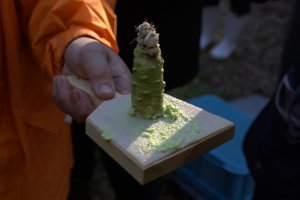The Izu Peninsula in Shizuoka is mostly famed for its hot spring and beach resorts, pulling in huge crowds from nearby Tokyo on weekends and holidays. However, Izu has a lot more to it than meets the eye.
If you look further, you’ll find it’s the home of one of Japan’s most famous exports, the well-known sushi complement — wasabi. If you go deeper into the mountains, you’ll find so much more.
Kawazu-zakura: One of Japan's Earliest Blooming Cherry Blossoms

If you time your visit right, you may catch the Kawazu-zakura cherry blossom when it’s in full bloom. This particular type of cherry tree is native to Kawazu town in Izu and is one of the earliest blooming cherry blossom varieties in Japan. The blossoms come in a lovely blushing pink color and generally bloom between early February to early March. The blossoms can last up to a month and when in full bloom they are a true sight to behold.
Good Food, Good Views

Being close to the ocean, Kawazu and other cities dotted along the coast have plenty of good seafood. Zendokodokaien, run by two sisters, is no exception. The restaurant not only serves a selection of locally-caught fish (so local that you can see the fishing harbor from the restaurant) but also has a great view of the Izu islands while you eat. If you’re a fan of an ocean view and great food, you may even want to stay there—there is a traditional-style Japanese inn in the same building.
Wasabi: The Real Deal

Chances are that although you may think you’ve had wasabi before, you probably haven’t. Fresh wasabi is completely different from most packaged wasabi that you find abroad, which is usually just horseradish with a coloring agent added. True wasabi is spicy, but also has a mild sweetness to it. If you want to try the real thing, then Izu is your best bet. The area is Japan’s number one wasabi growing region and it’s not only because of market share, or volume—the area has a longstanding history of cultivating the green root, as well as natural resources perfect for creating a quality product. Wasabi needs plenty of fresh, clean water and the right balance of sunlight.
Why not try your hand at picking your own wasabi, then eating a dish with it at Kawasemi Honkan in Shimizu city? Or, stop by Amagi Wasabi no Sato service area for soft serve ice cream with a dollop of wasabi on it so fresh that you can actually watch the lady behind the counter grate it before she adds it to your ice cream. The spicy burn is softened by the sweet vanilla ice cream and is quite the treat if you’re brave enough!
Architectural Masterpieces

Famed for hosting a slew of notable authors, artists, and film stars, Ochairou Murakami is no ordinary ryokan. While other traditional-style Japanese inns may boast lovely views, great food, hot baths, and a comfortable stay, Ochairou Murakami offers that and much, much more. Architect nerds, in particular, will find this inn a stunning and rare example of Japanese ingenuity and craftsmanship. The inn boasts several cultural heritage and architectural designations. Shoji screens like the one pictured above are constructed by hand and allow only a 0.1-millimeter margin of error — a truly stunning feat. Not only that, but many of the designs featured are very rare, some hailing their influence from the art nouveau movement. And that's only the tip of the architectural iceberg — there are so many other amazing design aspects they simply must be discovered in person. If you're looking for a Japanese inn that excels in everything, this is the place to be.
Cyclist Wonderland

But Izu isn’t all food and flowers. Izu city is the home of the Tokyo 2020 cycling races and has a velodrome (cycling arena) designed by world-renowned architect Ralph Schuermann, who also constructed velodromes used for the Rio Olympics in 2016 and the 2008 Beijing Olympics. Izu’s velodrome was finished as recently as 2011 and was the first wooden track cycling arena to be built in Japan. Visitors can stop by anytime during opening hours, even when a race isn’t on. If you’re lucky, you may spot some future Olympic athletes training on the track!
Izu city plans to make the area more cyclist-friendly over the next few years by creating cycle route maps, as well as constructing roadside service areas exclusively for cyclists.
Tofu and Wasabi — A Match Made in Heaven

Sitting beside the Kakitagawa river — known for its fresh, clear waters — is Kakitagawa Usuinomichi, a mini wonderland of delicious tofu and soy products, as well as rich cultural experience. The area not only offers a spectacular view of the cool waters of Kakitagawa, visitors are also welcome to drink some of the water firsthand. Kawasemi Honkan, the main restaurant the, makes use of this clean river water when cooking its delicious (and very reasonable) tofu set lunches. For those lucky enough to go wasabi harvesting the day before, guests can eat their tofu seasoned with freshly grated wasabi that they picked themselves.
Great Views of Mount Fuji
If you love landscape photography, then Izu is the perfect place for you. Not only does the peninsula have the previously mentioned beaches and hot spring resorts, it also has a multitude of viewing points of Mount Fuji. Izunokuni Panorama Park offers a stunning view of the mountain, together with Suruga Bay. It also has a tiny shrine that has been there since the Heian period, as well as a hot spring to dip your feet in as you take in the view.
Also, the recently-opened Mishima Sky Walk boasts another great view of Mount Fuji and Suruga Bay, coupled with fields of beautiful flowers, all viewable from a 400-meter long pedestrian suspension bridge—the longest in Japan! The nearby shops are also chockablock with souvenirs and local delicacies, including a giant ichigo daifuku—that’s a strawberry wrapped in mochi—and a seriously luxurious public bathroom; complete with scented toilet paper! Don’t believe me? Go see for yourself—you can thank me later.
































